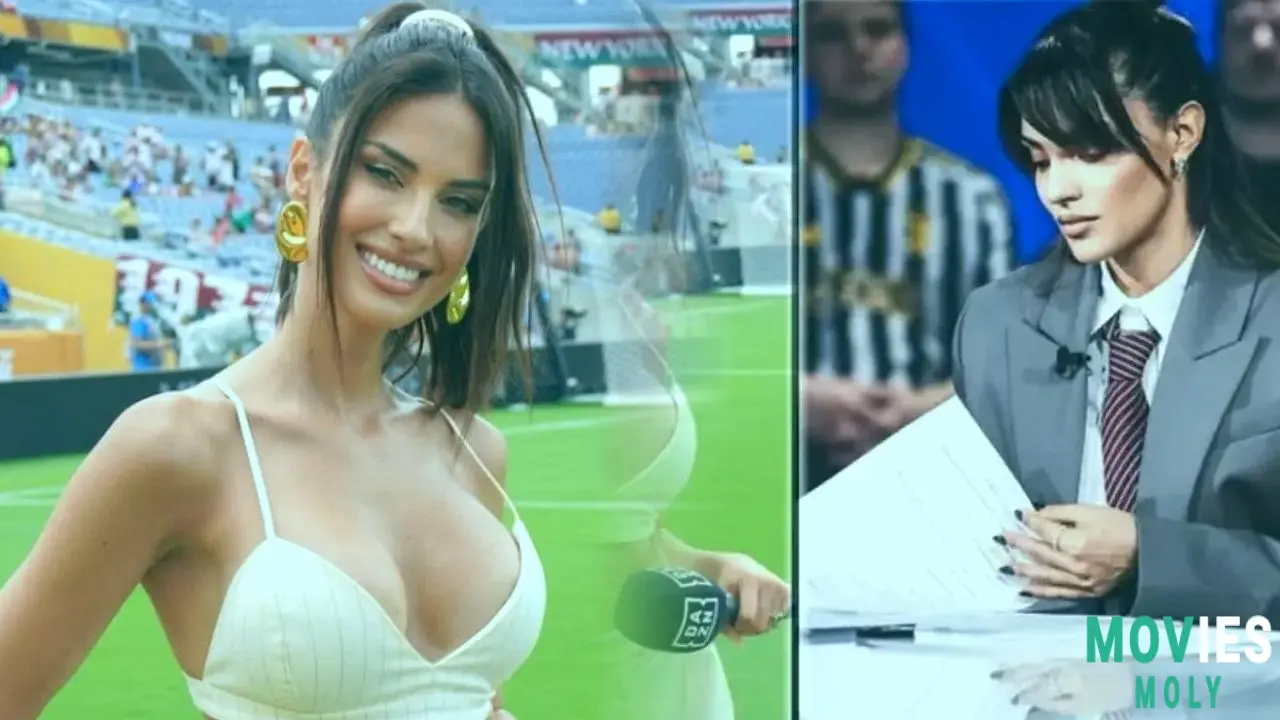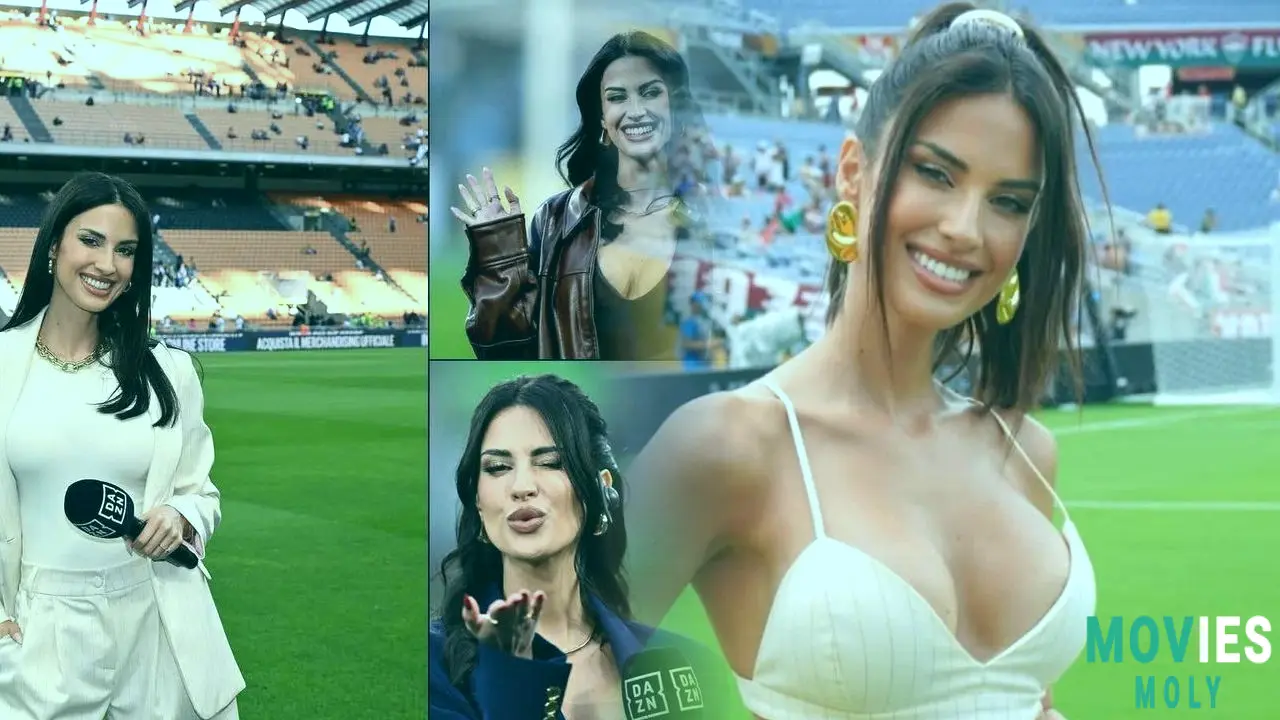There is no doubt that the world of sports broadcasting has changed a lot over the years. What used to be a very formal place has changed to accept new styles and people. But a recent fight between Dazn host Eleonora Incardona and colleague journalist Valentina Macheri has brought attention to the persistent conflict between personal expression and professional ethics in sports media. This argument is about more than just one outfit. It makes us think about the changing position of women in sports journalism, media ethics, and what audiences expect.
It's interesting to me how quickly a small event can start a big conversation. There is little doubt that Incardona's appearance at the Club World Cup, especially the clothes she wore, got a lot of attention. Some people liked her style, but others were quick to condemn it. This started a discourse that brought up bigger problems in the industry. This makes it even more interesting to think about what professionalism really means in today's sports broadcasting and how female journalists deal with these demands that are often at odds with each other.
The Spark: Eleonora Incardona's Clothes at the Club World CupDuring her coverage of the Club World Cup, DAZN broadcaster Eleonora Incardona attracted waves, especially for her wardrobe, which included a striped cream suit with a bra-like top underneath. This choice instantly went viral, getting both praise and harsh condemnation on social media. Someone on social media said, "You're working, not at the beach." Someone else asked, "What does this have to do with serious sports journalism or football?" But several fans also backed her up. One person said, "You're one of the reasons this tournament is worth watching."
I think Incardona's costume, whether she meant it or not, became a symbol in a bigger conversation. It showed that people often pay more attention to how female sports presenters seem than how male sports presenters look. This isn't a new problem, but it keeps happening in an industry where males are in charge.
Valentina Macheri's Critique: Professionalism vs. Personal Style

First Reactions and What People Think
Valentina Macheri, a Swiss broadcaster Blue presenter for the Champions League, publicly insulted Eleonora Incardona and other DAZN Italian presenters, including as Giusy Meloni, Diletta Leotta, and Marialuisa Jacobelli. This made the controversy much worse. Macheri said that their clothes weren't professional, stylish, or classy. She said that wearing clothes like that "doesn't show any intention of engaging as equals with players or officials" and that it "borders on vulgar."
Macheri's Point of View on "Fuck Female Empowerment"
In her book "Fuck Female Empowerment: A Great Mistake of Modern Feminism," Macheri criticizes how female reporters are sometimes shown in Italy, saying that they "walk a fine line" between image and professionalism. She specifically criticized Incardona's manner, saying that Incardona "mainly presents the betting odds" and "does it very sexy." Sometimes in a rude way. I find this point of view very intriguing because it doesn't only see the problem as a dress code violation, but as a perceived redirection of the movement for women's rights. It makes you think: does focusing on looks, even if the person chooses to do so, hurt the struggle for equal rights in the workplace?
Incardona vs. Diletta Leotta and Melissa Satta
This isn't the first time that well-known Italian female sports reporters have been under such close scrutiny. Diletta Leotta, another well-known DAZN celebrity, has also been the topic of a lot of discussion over how she looks on TV. Paola Ferrari, a veteran journalist, has been quite critical of what she considers the "spectacularization in the aesthetic sense of the female figure in football." Ferrari didn't like Melissa Satta's job as a football pundit, especially when she took off her jacket to show off her top, which Ferrari thought was "mortifying." Ferrari also said that she wouldn't want Leotta to be a role model for her daughter because "you can't mythologize a perfect woman image with gravity-defying breasts; it's not real." This historical context demonstrates that the debate over what female sports reporters should wear is a common one, often bringing up the idea that there is a conflict between how they look and their journalistic integrity.
DAZN's Position and the Freedom of Presenters
DAZN has allegedly backed its presenters' ability to choose the image in which they feel confident in reaction to the incident. Eleonora Incardona said, "Everyone has the right to their own style," and "the main thing is the quality of the interview, not how you look." I like that DAZN says it supports presenter autonomy, but I wonder if a clearer corporate policy or set of rules could help in these instances. Their global employee rules stress honesty, moral values, and a culture of working together and including everyone. But the details of the dress code are often unclear, which allows for different interpretations and public debate.
The Bigger Issue: Women's Rights in Sports Broadcasting
The "Spectacularization" of Women in Sports
This whole conversation brings up the ongoing problem of how sports media "spectacularizes" women. It's clear that for a long time, women in sports, whether they are athletes or journalists, have been judged more on how they look than on their skills or knowledge. This isn't just about people's decisions; it's a problem with the system that sometimes uses women's bodies to get people to watch instead of their professional work. One analyst said, "The way female athletes are shown on sports websites compared to the words used to describe them shows a clear 'othering' within the genre."
What the audience wants vs. what the presenter can do
There is a split opinion in the public conversation on social media. Some people think that presenters should wear a certain way to "impress with wit," while others say that how someone looks is a way of expressing themselves and shouldn't affect their work. There is a lot of conflict between what the audience wants and what the presenter can do. Journalists work for a media company, thus they should act professionally. On the other side, severe dress regulations, especially for women, can feel like they are holding people back and are out of date.
How social media made the controversy worse
There's no doubt that social media made this issue much bigger. A single picture or video can go viral in a matter of minutes, starting a huge conversation. Because information spreads so quickly, every story is subject to intensive public scrutiny and immediate comment, which often leads to strong opinions on both sides.
I think this shows a big problem for sports journalists today: how to stay professional and honest when online platforms make it hard to tell the difference between work and play.
The argument about Eleonora Incardona's clothing on DAZN shows how sports journalism is still at odds with letting people express themselves and being seen as professional. #SportsMedia #DAZN
Is it the clothes or the writing that matters? The DAZN presenter scandal brings up an important issue of how to support women in broadcasting. #SportsJournalism #MediaEthics
You can interact with people directly on social media, but it also makes it easier for bullies and false information to propagate. It's a double-edged blade that may give people power but also make places where people only hear criticism.
Valentina Macheri's criticism of DAZN's Eleonora Incardona starts a bigger conversation about dress codes and "spectacularization" in sports media. A must-read for information about the sector. #DAZNNews
In the past, there have been debates in the media about dress codes.
This isn't a new battle. Women in public-facing roles have been criticized for their clothing throughout history. In sports, there have been many times when female athletes and presenters have had to follow tight clothing requirements that were often sexist. For example, in 2011, the Badminton World Federation told women to wear short skirts, but this rule was later changed because people were so upset. Tennis has had its fair share of arguments, too. For example, Suzanne Lenglen wore shorter skirts in the early 1900s to break the rules at Wimbledon, which had a strict all-white clothing code. These examples from the past indicate that there is always a conflict between tradition, professionalism, and changing societal norms in sports and the media.
Beyond the Outfit: Putting Quality and Content First in JournalismFor me, the most important thing to remember in this discussion is the quality of journalism. While looks might affect how people think, they should never be more important than the real information and expertise a journalist has. We need to put a reporter's ability to inform, analyze, and interact with the subject matter ahead of their dress choices. "How much does appearance really affect the credibility of journalists?" said one reporter.
The DAZN presenter scandal is a little example of the problems women confront in sports sectors that are mostly male. #FemaleEmpowerment #SportsBiz
The problem is that these arguments take away from the critical work that women journalists perform to break down barriers and give us useful information about sports.
What this means for DAZN and the sports media landscapeThis argument is mostly about people, but it has effects for DAZN and the sports media as a whole. Brand image and how the public sees a company are very important in a competitive streaming industry. DAZN wants to be the "global home of sport," with lots of interesting content and detailed data. If not handled appropriately, these kinds of public disputes can either promote negative preconceptions or show how committed a platform is to diversity and modern professionalism. It's hard to find the right balance between letting people express themselves and keeping a corporate image that appeals to a lot of people.
What Other Journalists and Ethicists ThinkWhat Broadcasters and Journalists Can Learn
Media ethicists and experienced journalists typically stress the need to report the truth, be fair, and not be biased. They also stress how important it is to be open and honest and to stay away from conflicts of interest. Dress rules aren't often spelled out in ethical guidelines, but the basic ideas of professionalism and keeping your integrity are. I think this event is a good reminder that media companies and individual journalists need to always think about how their presentation fits with their journalistic objective.
How much does how someone looks really affect how credible they are as a journalist? The DAZN Eleonora Incardona argument makes us think about the standards of the media. #JournalismDebate #DAZN
One fashion expert even said that Incardona's dress was "perfectly acceptable in leisure time... But Ms. Incardona was in the business world, and that's not professional in any way and has nothing to do with style." Even if this point of view is personal, it shows what most people anticipate from professional clothing.
The Eleonora Incardona and Valentina Macheri discussion is more than simply a short fight on the internet. It's a sign of deeper, ongoing talks about gender, professionalism, and how sports writing is changing. As the industry changes, it will be important to create a balance that allows people to express themselves while also protecting journalistic integrity. Instead of only critiquing clothes, I think we can use these times to make the workplace more welcoming and respectful, where a journalist's worth is always based on their skills and knowledge.






